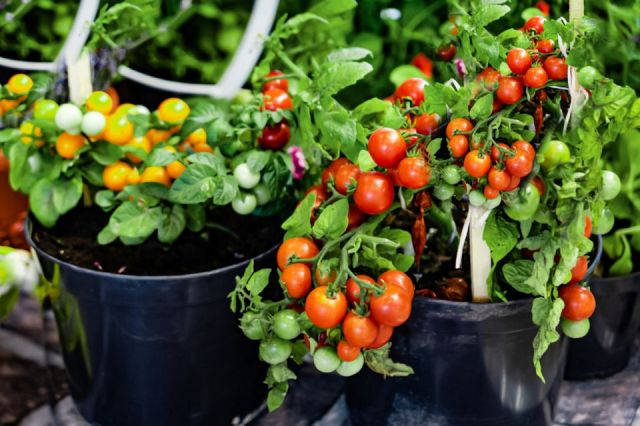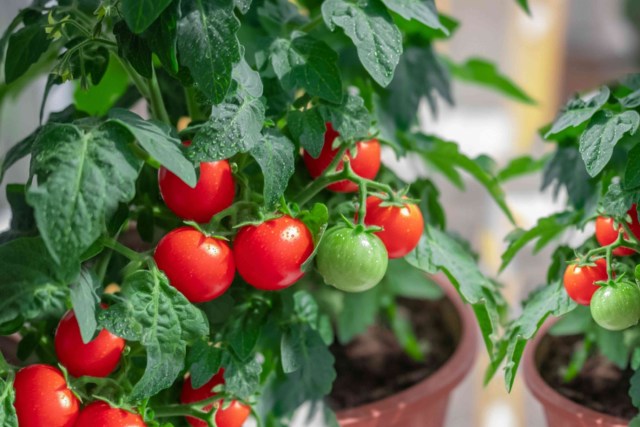
We hear we are again. Summer is approaching and now is the time to plant your Summer Tomato crop. Although growing tomatoes can be challenging to grow in containers, they continue to rate among the most popular of summer vegetables. Five controllable factors are essential for successfully growing tomato plants in containers.
A great benefit to growing tomatoes in containers is portability; you can move the containers to take advantage of the best growing conditions. Containers are particularly useful if you don’t have in-ground garden space; containers can be placed on a balcony, porch, patio, driveway, or deck. You can enjoy homegrown tomatoes even if you don’t have room for a traditional garden.
Growing Tomatoes: Use Really Big Containers

One of the most important things you can do to ensure success is to use a big enough container—the bigger, the better. For one plant, you need a container that is at least 1 square foot, but 2 square feet is better. Five-gallon buckets are the perfect size for one plant. Fill the pot with high-quality potting soil and make sure the container has good drainage.
Some tomato growers suggest planting herbs or other plants in the same container. Beginners should refrain from adding additional plants to the container, even if you have a massive container. You do not want other plants competing with the tomato plant for water or nutrients.
Plant Tomatoes Deeply

Most vegetable plant seedlings are planted at the same depth as their original containers; tomatoes are the exception. When planting a tomato seedling, remove the bottom few sets of leaves, and dig a hole deep enough so that most of the plant is buried in the planting hole.1 A tomato plant will produce roots along the buried part of its stem, developing a strong root system and sturdier plants
Water Soil Consistently

Because containers can dry out quickly, achieving success growing tomatoes in containers depends on maintaining consistent moisture. The soil’s moisture content is one of the biggest challenges you face with container gardening. If soil is fast-draining, consider using a water-retaining additive, self-watering container, or checking soil moisture every day. Keep in mind that the ambient heat around a container can warm up the soil more quickly than in-ground plantings.
If a tomato plant receives too little water, the plant will wilt and weaken, and the tomatoes could develop blossom end rot. If your plants are receiving inconsistent watering, tomato fruits can crack or split. During sweltering summer days or hot and windy days, you might have to water plants twice a day. A best watering practice is to water plants in the morning to provide moisture all day and enable the foliage to dry. It is important to apply water directly on the soil and avoid wetting the foliage: this can encourage blight and fungus.
Another important rule of thumb: the soil should be moist but not soggy. Too much water could cause the plant’s roots to rot. Make sure the container has several drainage holes. If the container only has one drainage hole, add several more. If your tomato plant is receiving too much rain, flooding the plant, and water-logging the soil, move the container to a sheltered area to protect it.
Feed Your Growing Tomatoes

Tomatoes are heavy feeders, and when they are planted in containers they require feeding about every two weeks. Make sure to feed your plants with the primary nutrients they require—nitrogen, phosphorus, and potassium—all essential for growing almost anything in containers. Some potting soils already have fertilisers included in them so read the soil bag to determine if these essential nutrients are already included in the mix.1 If the potting soil does not include fertiliser, feed the plants with an all-purpose slow-release fertiliser or a tomato-specific fertiliser.
Let the Sunshine In

Tomato plants require full sun, which means at least 6 to 8 hours per day between the hours of 10 a.m. and 4 p.m. When deciding where to locate tomato containers, find a location with that amount of sun. You can use a measuring device like a sun calculator or go outdoors to inspect the amount of sunlight the location receives during the day.
If your plants aren’t getting enough sun, move the containers to a location that does. Continuously monitor the location throughout the growing season. Depending upon the time of year, what was once a full-sun area can become a shady spot during a critical part of the day.
While tomatoes thrive in full sun, too much sun can kill young plants if they are not hardened off or acclimated slowly to outdoor growing conditions. Too much early exposure to wind and sun can weaken or destroy young plants.
Tomato plants like warm temperatures. If temperatures drop below 50 degrees, bring the plants inside, or protect them from the cold. If temperatures are sustained at more than 90 degrees, the plant stops producing flowers and fruit might not mature.








